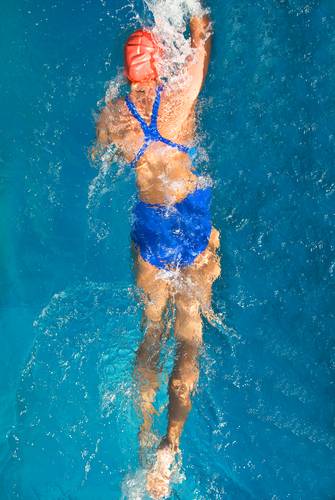In my sport of swimming, and likely in others also, athletes use stretching, take ice baths, wear compression gear, get massages, and drink recovery shakes in the name of speedy muscle recovery. Recovery in any sport is a crucial aspect of training. While some athletes have a preferred method or routine that fits their training program, recent studies have provided some scientific evidence as to what method may actually be more beneficial over another.
A recent study published in the Journal of Sports Medicine and Physical Fitness, looked at three classical recovery methods in seventeen elite male adult swimmers. The testing protocol involved two repetitions of 200m front crawl with 10 minutes of recovery time, with evaluation of recovery measured as clearance of serum lactate, as well as repeated performance time. The recovery methods tested in this study were massage, active recovery, and passive recovery.
The study revealed that all three recovery methods resulted in a significant decrease in blood lactate, however there was a significant difference in the levels of blood lactate clearance between them. A significant difference in performance time was also observed after all three recovery methods; however no significant difference was noted in performance time between active recovery and massage.
This study concluded that in the testing conditions used for this swim test set, active recovery was the most efficient method at clearing blood lactate, followed by massage, and finally passive recovery, while all being effective at clearing blood lactate. Further, it concluded that both active recovery and massage were equally effective at improving performance time post-recovery, while being more effective than passive recovery.
So the take home message from this study could possibly be that for swimming, an ideal mode of recovery would include both active recovery and massage for improved lactate clearance and performance time. USA Swimming already recommends active recovery for their swimmers (also referred to as cool down period, it is variable depending on the age of swimmer and the distance raced).
 But swimming itself could lend itself useful as a recovery methodology of active recovery. Another study published in the International Journal of Sports Medicine, looked at the performance of nine top triathletes. The athletes performed an interval run of 8 x 3 minutes at 85% to 90% of VO2 peak velocity on two separate occasions. Ten hours after the run, they either swam 2,000 meters or laid down for an equal amount of time. Fourteen hours after that, the subjects performed a high-intensity run to fatigue to assess how well their running performance had recovered from the previous day’s interval sessions.
But swimming itself could lend itself useful as a recovery methodology of active recovery. Another study published in the International Journal of Sports Medicine, looked at the performance of nine top triathletes. The athletes performed an interval run of 8 x 3 minutes at 85% to 90% of VO2 peak velocity on two separate occasions. Ten hours after the run, they either swam 2,000 meters or laid down for an equal amount of time. Fourteen hours after that, the subjects performed a high-intensity run to fatigue to assess how well their running performance had recovered from the previous day’s interval sessions.
The results showed the athletes had an improvement of 14% in their run time to fatigue after swimming for recovery compared to lying still (13:50 versus 12:08) concomitant with a decrease in the levels of c-reactive protein, a biomarker for inflammation. This suggests that swimming for recovery enhanced subsequent run performance by attenuating tissue inflammation caused by initial exertion, as well as benefitting from the hydrostatic properties of water. Interestingly the study also found there was no significant different in the perceived recovery between the two test groups while clearly showing differences in performance.
It would be plausible to infer that using swimming as an active recovery method is the way to go for swimmers, triathletes, and potentially runners based on the studies mentioned. For triathletes this information can be useful in planning training sessions, by including their swims on days after running. But could this recovery method also be applied to other sports? Many sports partially rely on running for improved performance: soccer, football, rugby, and CrossFit, to name a few. But if in the latter study recovery swimming improved performance due to attenuation of tissue inflammation, it is possible that recovery swimming could universally apply to any sport that causes tissue inflammation upon exertion (possibly 80-90% of sports) and not just running.
Photos courtesy of Shutterstock.






